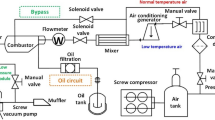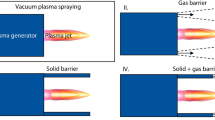Abstract
In order to study air discharge characteristics in the inlet of supersonic aircraft and explore an effective way to avoid such adverse regimes of discharge as spark, arc, or corona discharge, a nanosecond pulsed pin-to-plate discharge experiment is carried out for pressure ranging from 500 to 5000 Pa and temperature from 295 to 425 K. The study shows that glow-to-corona and corona-to-glow transitions can be realized by changing pressure. Specifically, with the temperature of 295 K and interelectrode distance of 10 mm, the pressures of corona discharge and glow discharge are 4500 and 1000 Pa, respectively, for the corresponding applied voltage of 4.56 and 8.25 kV. However, glow-to-spark transition cannot be obtained by varying pressure but increasing the applied voltage, which is a determined factor, and the peak voltage increases to 12.4 kV under spark regime. Overall, the regimes of discharge are jointly determined by interelectrode distance and pressure; but temperature could also effectively influence the discharge, the higher the temperature, the easier the breakdown is. The experiment results pave the way for follow-up further research on the characteristics of discharge in supersonic airflow.












Similar content being viewed by others
REFERENCES
I. V. Adamovich and M. Nishihara, in Proceedings of the 29th International Conference on Phenomena in Ionized Gases, Cancún, 2009.
S. V. Bobashev, A. V. Erofeev, and T. A. Lapushkina, in Proceedings of the 44th AIAA Aerospace Sciences Meeting and Exhibition, Reno, NV, 2006, AIAA Paper 2006-1373.
P. Y. Yang, B. L. Zhang, and Y. W. Li, Acta Aeronout. Astronaut. Sinica 35, 1539 (2014) [in Chinese].
G. Correale, I. B. Popov, A. E. Rakitin, and A. Y. Starikovski, in Proceedings of the 49th Aerospace Sciences Meeting, Orlando, FL, 2011, AIAA Paper 2011-1079.
N. A. Popov, in Proceedings of the 51st AIAA Aerospace Sciences Meeting, Dallas, TX, 2013, AIAA Paper 2013-1052.
Y. X. Long, H. X. Ling, X. S. Meng, F. Liu, and S. J. Luo, in Proceedings of the 52nd AIAA Aerospace Sciences Meeting, Reston, VA, 2014, AIAA Paper 2014-0933.
M. C. Paliwoda and J. Rovey, in Proceedings of the 54th AIAA Science and Technology Forum and Exposition, San Diego, CA, 2016, AIAA Paper 2016-0197.
I. Sernenov, A. Starikovskiy, and N. Shneider, in Proceedings of the 54th AIAA Science and Technology Forum and Exposition, San Diego, CA, 2016, AIAA Paper 2016-4307.
A. C. Rousso, J. K. Lefkowitz, and Y. G. Ju, in Proceedings of the 54th AIAA Science and Technology Forum and Exposition, San Diego, CA, 2016, AIAA Paper 2016-0958.
R. C. Murray, S. H. Zaidi, and M. N. Shneider, in Proceedings of the 41st AIAA Aerospace Sciences Meeting and Exhibition, Reno, NV, 2003, AIAA Paper 2003-1049.
R. C. Murray, S. H. Zaidi, and M. R. Carraro, in Proceedings of the 42nd AIAA Aerospace Sciences Meeting and Exhibition, Reno, NV, 2004, AIAA Paper 2004-1025.
P. Tardiveau, N. Moreau, and S. Bentaleb, J. Phys. D 42, 175202 (2009).
P. Tardiveau, N. Moreau, and F. Jorand, IEEE Trans. Plasma Sci. 36, 894 (2008).
V. F. Tarasenko, E. Kh. Baksht, and E. A. Sosnin, Plasma Phys. Rep. 44, 520 (2018).
M. Janda, Z. Machala, and L. Dvonč, J. Phys. D 48, 035201 (2015).
D. Z. Pai, D. A. Lacoste, and C. O. Laux, Plasma Sources Sci. Technol. 19, 065015 (2010).
D. Z. Pai, G. D. Stancu, and D. A. Lacoste, Plasma Sources Sci. Technol. 18, 045030 (2009).
D. Z. Pai, D. A. Lacoste, and C. O. Laux, J. Appl. Phys. 107, 093303 (2010).
T. Shao, V. F. Tarasenko, and C. Zhang, J. Appl. Phys. 113, 093301 (2013).
T. Shao, C. Zhang, and R. X. Wang, High Voltage Eng. 42, 685 (2016) [in Chinese].
Funding
This work was supported by the National Natural Science Foundation of China (11372352, 51776222) and China Postdoctoral Science Foundation (2017T100772, 2016M590972).
Author information
Authors and Affiliations
Corresponding author
Additional information
The article is published in the original.
Rights and permissions
About this article
Cite this article
Ding, Z.W., Li, Y.W., Pang, L. et al. Regime Transition of Pin-to-Plate Nanosecond Pulsed Discharge under Low Pressure. Plasma Phys. Rep. 45, 492–500 (2019). https://doi.org/10.1134/S1063780X19050040
Received:
Revised:
Accepted:
Published:
Issue Date:
DOI: https://doi.org/10.1134/S1063780X19050040




